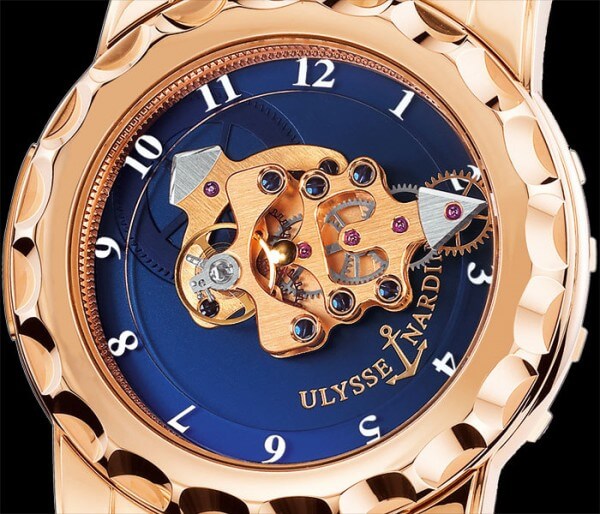All eyes are on Sion, a small town in the Swiss canton of Le Valais and hardly renowned as a centre of excellence in watchmaking. And yet, declares Hubert Lorenz, founder and CEO of Mimotec, “Sion has become the capital of micro- and nanotechnologies for the watchmaking industry.” The company Lorenz heads is certainly no stranger to this transformation. Established in 1998 and a year after moving to a new facility on the outskirts of town, Mimotec is now first stop for the manufacture of micro-components using a proprietary technology: UV-Liga, a combination of photolithography and electro-deposition.
This process structures micro-moulds by UV-radiating a resin to create cavities. These cavities are then filled with metal (nickel or nickel-phosphorous) to produce the required component. The advantages of UV-Liga technology compared with the traditional methods of stamping and EDM are lower cost, extreme precision and a remarkable mirror-polish surface. It should come as no surprise that Mimotec lists more than 200 watch companies among its clients and supplies over 2,500 different articles.
Creation of Sigatec in 2006
Mimotec’s expertise caught the attention of Ulysse Nardin, which has made innovative materials one of the hallmarks of its watches. Think back to the first Freak, unveiled in 2000 and whose “Dual Direct” silicon escapement, the brainchild of Ludwig Oechslin, curator of the Musée International de l’Horlogerie in La Chaux-de-Fonds, was produced by the Centre Suisse d’Électronique et de Microtechnique (CSEM). The CSEM also developed, from blueprints by Ulysse Nardin, a silicon balance spring that went on to integrate the “Dual Ulysse” second-generation escapement; it has equipped the Freak 28,800 since 2005, and later the “Anniversary” Calibre 160.

As Pierre Gygax, head of technology and industrial management at Ulysse Nardin, explains: “We had absolute faith that silicon was the material of the future. When we first went to work on this new escapement, we quickly realised it couldn’t be made from traditional materials. The solution was silicon, whose horological hour of glory had come.”
Full-scale industrial processes being outside the CSEM’s remit, Ulysse Nardin contacted Mimotec. Shortly after, in 2006, the two companies embarked on a joint enterprise and set up Sigatec, a specialist in the manufacture of silicon components. “Because we believed in these new processes, which produce micro-components in materials the profession had never previously considered, we turned a whole new page in watchmaking,” explained Rolf Schnyder, CEO of Ulysse Nardin which combines tradition and innovation by introducing new materials only “where they deliver a true benefit.” Says the CEO: “We’ve invested heavily since the launch of Freak, which is where it all began, but we’ve also opened a Pandora’s box and we can now say the future of mechanical watchmaking is safe. Of course, our watches are not toys for the wealthy but the product of genuine innovation.”
Ten years of R&D
This wasn’t all. Alongside its research into silicon, Ulysse Nardin also looked closer at diamond. “Polycrystalline diamond wheels have exceptional properties,” Pierre Gygax commented. “We’ve also produced a diamond balance spring which has excellent isochronism. These initial trials produced the Freak Diamond Heart. Still, we had to face the fact that the only way we could commercialise diamond components was in exceptional timepieces, which isn’t our goal. We are far more concerned by the longevity of our watches. We want to produce watches that function, without lubricant, for a very long time to come.”
After a full ten years of research, the solution came in the form of technology developed by the German company GFD to coat silicon parts with a nanocrystalline diamond film. This has sparked a second joint venture between Ulysse Nardin and GFD, namely Diamaze Microtechnology which has set up business in Mimotec’s facility in Sion. 25% lighter than titanium which is already very light and ten times harder than titanium or steel, diamond also has a very low friction coefficient meaning it can go without lubricant, and resists wear. “This makes it the ideal material in micromechanics where minimum energy loss, lightness and mechanical strength are all essential properties,” explained Peter Gluche, CEO of Diamaze.
Producing diamond with heat
Using natural diamond was out of the question. Rather, Peter Gluche and his teams threw their energies into perfecting and developing on an industrial scale a process that has been around since the 1980s: Chemical Vapor Deposition (CVD). Says Peter Gluche: “Using carbon from methane, this process crystallises a thin film of diamond. The innovation is to produce the diamond by heating in a depressurised chamber at approximately 1 mbar. The substrate, in this instance silicon, is covered with a layer of diamond comprising crystals of various sizes that fuse together. This process requires a temperature of around 2,300°C.”
Four reactor models were made to stabilise what is currently a world-first industrial process. Watchmaking has made an age-old dream – to produce synthetic diamond – reality. No small thanks to Ulysse Nardin.



















